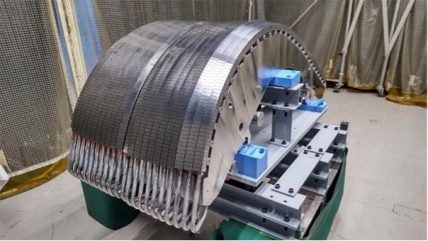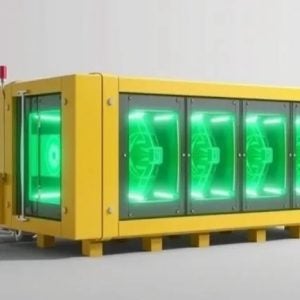
Japan’s Mitsubishi Heavy Industries (MHI) and National Institutes for Quantum Science and Technology (QST), have completed a key component for the International Thermonuclear Experimental Reactor (ITER) under construction in France. Manufacture of a prototype outer vertical target (OVT), which began in June 2020, has been completed and is now ready for series production.
The OVT is one of the key components of the divertor one of the most crucial components in magnetic field confined fusion reactors such as tokamaks. It plays an important role in the removal or exhaust of unburned fuel in the core plasma and impurities such as helium ash generated by the fusion reaction, which are necessary for stable confinement of the plasma. The divertor comprises four parts: the OVT, the cassette body and inner vertical target being manufactured in the EU, and the dome being provided by Russia.
Last year, the high heat flux test on plasma facing units (PFUs) of the OVT was performed by the ITER Organisation and heat removal performance was confirmed. MHI’s manufacturing processes for the PFU were then certified by ITER. MHI has now completed a prototype that will be a full-scale mock-up of the OVT and is ready for series production.
The heat load on the divertor target reaches a maximum of 20 MWt per square metre. This is equivalent to the surface thermal load on an asteroid probe during re-entry into the atmosphere, and approximately 30 times the surface thermal load on a Space Shuttle.
The divertor is the component of the tokamak device that is directly exposed to the heat load and high energy particle loading from the plasma. For this reason, it requires special materials such as tungsten, which has a high melting point but is difficult to machine. High-precision fabrication and processing technologies were developed to produce the structures.
In May, MHI was awarded a contract by QST to supply a further 12 OVTs for the divertor to be used in ITER. The contract followed the initial production order for the manufacture of six units (1-6) received in 2021. With the additional 12 units (7-18), MHI will manufacture 18 of the total 54 outer vertical targets. The remainder will be manufactured by QST. MHI said production of these units will be completed successively, with delivery to QST expected to begin in 2026.
QST was focusing on the R&D of divertors before the ITER project began, and MHI has leveraged its manufacturing capabilities to produce the OVT prototype. QST previously worked on the production of toroidal field (TF) coils, another core component of ITER, and had shipped all nine TF coils to the ITER site by the end of 2023. MHI was responsible for five of the nine TF coils. MHI is now proceeding with series production of the OVT to be delivered by QST to ITER, and will deliver six units to QST in FY 2025.
ITER is a first-of-a-kind global collaboration. As the host, Europe contributes almost half of the costs of its construction (45.6%), while the other six members of this joint international venture (China, India, Japan, South Korea, Russia and the US), contribute equally for the remaining expenses (9.1% each). However, in practice, the members deliver little monetary contribution to the project, instead providing ‘in-kind’ contributions of components, systems or buildings.
The goal of ITER is to operate at 500 MW (for at least 400 seconds continuously) with 50 MW of plasma heating power input. Some 33 nations are collaborating in the construction of ITER, which began in 2010, many of them through their Domestic Agencies.






